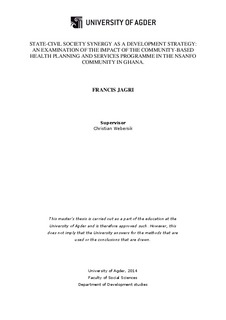| dc.contributor.author | Jagri, Francis Nyaja | |
| dc.date.accessioned | 2014-10-01T06:48:49Z | |
| dc.date.available | 2014-10-01T06:48:49Z | |
| dc.date.issued | 2014 | |
| dc.identifier.uri | http://hdl.handle.net/11250/222378 | |
| dc.description | Master thesis in development management - University of Agder 2014 | nb_NO |
| dc.description.abstract | The state in many developing countries has been the dominant provider of public goods and services with little involvement of civil society. Civil society in such context has often assumed the role of passive agents instead of being active participants in the country’s developmental agenda. Contemporary development practitioners have criticised this conventional relationship and called for partnership between both entities in co-producing public goods and services. A major reason adduced by authors to support the necessity for such partnership is that, there are some functions better performed by the state and others better performed by civil society thus combining the resources of both the state and civil society will result in more effective performance. These theoretical foundations of state-civil society synergy manifest in the collaborative healthcare delivery in the Nsanfo community in Ghana. The absence of adequate and affordable public healthcare facilities and personnel in the community has necessitated the introduction of the Community-based Health Planning and Services (CHPS) programme as a strategy to improve healthcare delivery in the Nsanfo community. This CHPS is a community-based scheme which provides health services through partnerships between the Ghana Health Service and community volunteers. Under the programme, some community volunteers are trained in basic health care provision to enable them render emergency treatment services in households before referring patients to health care institutions if the need arises. This study, therefore, sought to examine the impact of this CHPS programme in the Nsanfo community, identify the nature of state-civil society synergy and threats to this synergy. The mixed methods strategy which combines both qualitative and quantitative techniques was adopted to achieve the objective of the study. The findings from the field indicate that even though the programme has greatly improved the healthcare conditions of the people of Nsanfo, there is less participation of the community members in maintaining the CHPS facility. This is due to suspicions of financial embezzlements on the part of the nurses working at the CHPS facility. Inadequate logistics and motivation for the volunteers also threatens the synergy in the CHPS programme. | nb_NO |
| dc.language.iso | eng | nb_NO |
| dc.publisher | Universitet i Agder / University of Agder | nb_NO |
| dc.title | State-civil society synergy as a development strategy: an examination of the impact of the community-based health planning and services programme in the Nsanfo community in Ghana | nb_NO |
| dc.type | Master thesis | nb_NO |
| dc.subject.nsi | VDP::Social science: 200::Political science and organizational theory: 240::Public and private administration: 242 | nb_NO |
| dc.subject.nsi | VDP::Medical disciplines: 700::Health sciences: 800::Health service and health administration research: 806 | nb_NO |
| dc.source.pagenumber | 156 p. | nb_NO |
